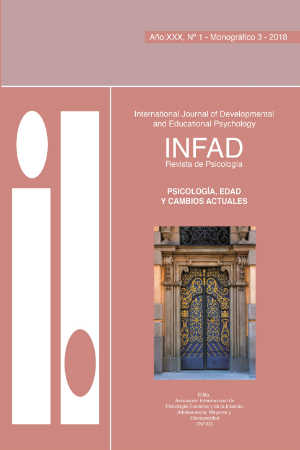Alfabeto visual y caligrafía como herramienta terapéutica con personas con demencia temprana
##plugins.themes.bootstrap3.article.main##
Аннотация
Скачивания
##plugins.themes.bootstrap3.article.details##
Aquellos autores/as que tengan publicaciones con esta revista, aceptan los términos siguientes:
- Los autores/as conservarán sus derechos de autor y garantizarán a la revista el derecho de primera publicación de su obra, el cuál estará simultáneamente sujeto a la Licencia de reconocimiento de Creative Commons que permite a terceros copiar y redistribuir el material en cualquier medio o formato bajo los siguientes términos: —se debe dar crédito de manera adecuada, brindar un enlace a la licencia, e indicar si se han realizado cambios. Puede hacerlo en cualquier forma razonable, pero no de forma tal que sugiera que usted o su uso tienen el apoyo de la licenciante (Atribución); — no se puede hacer uso del material con propósitos comerciales (No Comercial); — si se remezcla, transforma o crea a partir del material, no podrá distribuirse el material modificado (Sin Derivadas).
- Los autores/as podrán adoptar otros acuerdos de licencia no exclusiva de distribución de la versión de la obra publicada (p. ej.: depositarla en un archivo telemático institucional o publicarla en un volumen monográfico) siempre que se indique la publicación inicial en esta revista.
- Se permite y recomienda a los autores/as difundir su obra a través de Internet (p. ej.: en archivos telemáticos institucionales o en su página web) antes y durante el proceso de envío, lo cual puede producir intercambios interesantes y aumentar las citas de la obra publicada. (Véase El efecto del acceso abierto).

Este obra está bajo una licencia de Creative Commons Reconocimiento-NoComercial-SinObraDerivada 4.0 Internacional.
Библиографические ссылки
Chancellor, B. Duncan, A & Chatterjee, A. (2014). Review Art Therapy for Alzheimer’s Disease and Other Dementias. Journal of Alzheimer’s Disease 39 (2014) 1–11.doi 10.3233/JAD-131295
Geue K, Goetze H, Buttstaedt M, Kleinert E, Richter D, Singer, S. (2010). An overview of art therapy interventions for cáncer patients and the results of research. Complement Ther Med 18, 160170
Gray AE. (2011). Expressive arts therapies:Working with survivors of torture. Torture 21, 39-47.
López, L. (2014). Educación artística en personas con Demencia Temprana. International Journal of Developmental and Educational Psychology. INFAD Revista de Psicología, Nº1-Vol.1, ISSN: 0214-9877. 527-534.
Miller BL, Hou CE. (2004). Portraits of artists: Emergence of visual creativity in dementia. Arch Neurol 61, 842-844.
Stewart, EG. (2004). Art therapy and neuroscience blend:Working with patients who have dementia. Art Ther J Am Art Ther Assoc 21, 148-155.
Stuckey HL, Nobel J. (2010). The connection between art, healing, and public health: A review of current literature. Am J Public Health 100, 254-263.
Ullán, A.M. Belver,M.H. Badia, M. Moreno,C. Garrido, E. Gómez-Isla, J. Gonzaléz-Ingelmo,E. Delgado , J. Serrano, I. Herrero, C. Manzanera,P & Tejedor, L. (2012). Contributions of an artistic educational program for older people with early dementia: An exploratory qualitative study. Dementia. 0(0). doi: 10.1177/1471301211430650. 1-22.

